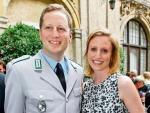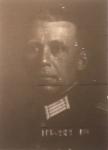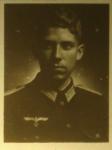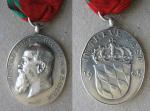-
Posts
4,908 -
Joined
-
Last visited
-
Days Won
97
Content Type
Profiles
Forums
Blogs
Gallery
Events
Store
Everything posted by Dave Danner
-
That clears that up! Both Sonntag and Sommer are among those with no first names in the rolls. So now I can add Sonntag's first name and place and year of birth. Do you have any other vital statistics (day and month of birth, date of death, what he did in the 2.WK)? I am trying to include as much information as possible, to make the rolls more than just a list of names, but also a biographical resource. I will be in Rudolstadt next month. I need to get some missing Ehrenkreuz information from the archives, and some information on other awards. I will also be looking at the Vorschläge for the Ehrenkreuz. I hope these will include the missing first names or other details as well as any other awards received at the time of the Vorschlag. I can also see if it says exactly what your guy got his award for. Regards, Dave
-
In your original post you said Friedrich Sommer, Now you have Friedrich Sonntag. Which is correct? A Lt.d.L. Sommer received the SEK3X on 5.6.15 while serving in RIR 82. His award was from Schwarzburg-Sondershausen. A Lt. Sonntag received the SEK3X on 12.2.16 while serving in III./IR 96. His award was from Schwarzburg-Rudolstadt. I assume you just had the wrong name in the original post? Sonntag certainly makes more sense, since known SEK3X/REK3X combinations are almost all people with an IR 96 connection. Two exceptions are later Generaloberst Gotthard Heinrici (IR 95) and later Gen.d.Inf. Erich Lüdke (IR 71), both of whom received their SEK3X from Schwarzburg-Sondershausen.
-
Neither Gerd nor Rick are around, but for those who are interested... It's kind of odd for Karl Freiherr von Andrian-Werburg to complain about not getting any Iron Crosses, since he got four. Also, at the time of the Verdun battles, he already had one: 1914 Iron Cross 2nd Class, 16.10.1914 1914 Iron Cross 1st Class, 25.6.1916 1939 Clasp to the Iron Cross 2nd Class: 1.5.1942 1939 Clasp to the Iron Cross 1st Class: 15.9.1942 And, for that matter: Knight's Cross with Swords of the Royal House Order of Hohenzollern: 23.4.1918 1939 War Merit Cross 2nd Class with Swords: 24.12.1940 1939 War Merit Cross 1st Class with Swords: 2.12.1941 His HOH3X was not in Geile's list, so there's one for Daniel to add, if he doesn't already have him. Regards, Dave
-
Regarding other house orders, we can see that at the wedding Prince Bernhard of Baden also wore his, the House Order of Fidelity. It appears that he is also wearing the Order of the Golden Fleece around the neck? A few other Monaco wedding pictures show the head of the house of Bragança wearing his Golden Fleece and Portuguese house orders, and one of the (disputed) heads of the House of Romanov, Grand Duchess Maria Vladimirovna, accompanied by her son, both wearing the Order of St. Andrew the First-Called.
-
An old topic I came across while searching for something else (pictures of Wehrmacht DAs in wear - thanks Claudio!). Regarding the original question, we cannot know for sure but I would say the likeliest combination is (1) a small silver and two bronze bravery medals or (2) a large silver and two small silvers. Less likely, but also possible, is a gold and two silvers. I recently saw a picture of a former Austrian NCO with the following combination of bravery ribbons: In his case, it was a Gold Bravery Medal, two Large Silver Bravery Medals, two Small Silver Bravery Medals, and a Merit Cross on the ribbon of the Bravery Medal. As a Wehrmacht officer, he went on to add the Iron Cross 1st and 2nd Class and the German Cross in Gold. Regards
-

Heer Family resemblance
Dave Danner replied to Dave Danner's topic in Germany: Third Reich: Research, Documentation & Photographs
Heinrici it is. Hartmut Heinrici, the son of Gotthard Heinrici. For comparison, here are Gotthard Heinrici's file photo and a wartime photo postcard from Wikipedia. -

Heer Family resemblance
Dave Danner replied to Dave Danner's topic in Germany: Third Reich: Research, Documentation & Photographs
I have on occasion described him as "the best German general you've never heard of," at least among English-speaking students of the war. To much conflict with superiors probably kept him from getting a baton, but too much skill, especially in defensive fighting, kept him from getting put out to pasture for good. -
It is not Alfred, the general's son. It might be another Alfred, per Glenn's Berlin reference. Rudolf von Wegerer, the commander of the 4th Landwehr Division and according to the Ehrenrangliste later Military Governor of Kalisch and a Gen.d.Inf.a.D., had three sons: Arthur, born 8.2.1878, was a Regierungsbaumeister. In 1914 he was the technische Hilfsarbeiter bei der Intendantur des XVIII.Armeekorps in Frankfurt a/M. On 1.8.1917 he became the Vorstand des Mil.Bauamts II in Thorn, and in 1918 he was supposed to become the technische Hilfsarbeiter bei der stellv. Intendantur des XVII.A.K. in Danzig, but this was rescinded. Alfred, born 22.2.1880: - Leutnant, 22.3.00 F3f - Oberleutnant, 18.10.09 J48i - Hauptmann, 27.1.14 Hh He served in FR 80, and then was transferred to FR 73 at the end of 1913. He's the FR 73 Hauptmann in the 1914 rank list. Camillo, born 29.10.1882. I have no information on him, but given his age (younger than Alfred, the youngest of the three 1914 Hauptleute von Wegerer), he isn't your guy either.
-
Keep in mind the Ethiopian calendar is off by several years from the Western one. Mine here has three bars dated "1931", "1932" and "1933", which correspond to 1939, 1940 and 1941 on the Western calendar.
-
Assuerus a the version of the Persian king Xerxes' name used in the Catholic Vulgate. Protestant Bibles usually use Ahasuerus.
-
The following are the recipients of both the SMK and the SEK3X from Schwarzburg-Sondershausen. For each, after the name, rank and unit, and award date, I have added what extra information I have. This information comes from multiple sources, including other published award rolls, rank lists, the Militär-Wochenblatt, and Wehrmacht personnel files. Fischer, Hermann Lt., RIR 251, SEK3X am 5.10.17 19.2.1894-12.4.1968; Genlt. i.d. Wehrmacht; RKdEK, EK1mSp39, EK2mSp39, Ostmed., GSF3bX, SMK, SEK3X, WVK4X, Baltenkreuz, WHDA1, VAs, Ärmelband "Kurland", FinnFK2X Haase, Armin Lt.d.R., RIR 253, SEK3X am 6.7.16 [Lt.d.R. am 27.1.16 (RIR 82)]; SMK, SEK3X Hansen, Karl Hptm., RIR 252, SEK3X am 8.10.18 1876-1965; Genlt.z.V. i. d. Wehrmacht; plM, HOH3X, EK1&2, SMK, SEK3X, ÖM3K, SA3b, EH3b, WHDA1, VAs Heymann, Julius Lt.d.R., IR 71, SEK3X am 6.7.16 Lt.d.R. am 27.12.15; SMK, SEK3X Hülle, Friedrich Hptm., Adj. 51.Res.Div., SEK3X am 25.6.18 14 Lt., IR 29, OLt. am 28.11.14, Hptm. am 18.12.15, Maj.a.D.; HOH3X, EK1&2, SMK, SEK3X, WVK4X Luther, August Lt.d.R., 1.Ers.Btl./IR 71, SEK3X am 8.11.16 Lt.d.R. am 27.12.15; Lehrer in Schnett, SMK, SEK3X Maempel, Rolf Lt., IR 95, SEK3X am 27.3.15 1895-1955; Lt. am 7.8.14, Oberst i.d. Wehrmacht; DKiG, EK1mSp39, EK2mSp39, EH3bX, SMK, CK, SEK3X, VAs, PzKpfAbz, UngVO4X Reißig, Artur Lt.d.R., kgl. sächs. UR 17, SEK3X am 15.1.15 sächsisch; SV3bX, SA3bX, SMK, SEK3X Scheider, Hugo Lt.d.L., IR 71, SEK3X am 28.4.15 Ldw.Bez. Sondershausen; Reichsbank-Beamter in Nordhausen; SMK, SEK3X Scheidig, Hermann Lt.d.R., IR 71, SEK3X am 29.11.15 Lt.d.R. am 29.1.15; Gerichts-Sekr. in Schalkau; SMK, SEK3X Schlegel, Rudolf Rittm., Kdr., MG-SS-Abt. 16, SEK3X am 19.12.17 Rittm. am 24.12.14 (Pat. 8.10.14); aus Bellstedt, S-Sond.; EH3aX, SMK, SEK3X Schobess, Hans Lt.d.R., IR 71, SEK3X am 15.3.17 Lt.d.R. am 15.12.16; aus Niederröblingen, Kr. Apolda, S.W.E; stud. Recht, Univ. Halle; EK1&2, GSF3bX, SMK, SEK3X Schunke, _____ OLt., IR 71, SEK3X am 10.2.15 14 Lt., Adj. III/IR 71, OLt. am 4.7.14, Hptm. am 18.8.15; EH3bX, SMK, SEK3X, RSt3 Solger, Wilhelm Hptm., 22. Res.-Div., SEK3X am 29.11.15 geb. 1.5.1876; Hptm.i.G. in Japan, 1911-14, 7.Armee (9.14-5.15), 22.RD (5.15-3.16), Fhr. III./IR 117 (3.-6.16), XIV.R.K. (6-9.16), Et.Insp. 6 (9.16-7.17), Pascha II (7.17-KE); Maj. am 28.6.16, OTLaD; HOH3X, EK2 (29.10.14), EK1 (23.8.15), ZM97, AK (15.6.17), HT, SA3aX, SMK, SEK3X [vermutlich außerdem türk. Auszeichnungen) Teicke, Emil OLt.d.R., IR 28, jetzt b. Ers.Btl./LIR 71, SEK3X am 30.9.17 Kaufmann in Hagen; OLt.d.R. am 24.10.16, zzt. Adj. Bez.Kdo. Sondershausen; SMK, SEK3X Voelker, Alexis Hptm.d.L.a.D., RFAR 46, jetzt techn. Leiter d. Betriebsabt. III d. Kriegsbekl.amt IX A.K. Altona, SEK3X am 24.7.15 SMK, SEK3X Weingarten, Hans Lt., IR 71, SEK3X am 6.7.16 Lt. am 25.9.15 (Pat. am 22.3.16); SMK, SEK3X Wilck, Hermann OLt., IR 71, SEK3X am 27.10.14 X zum SEK3; 28.10.1885-10.6.1967; Genlt.z.V. i.d. Wehrmacht; plM (9.10.18), DKiS (30.10.43), HOH3X, EK1mSp39, EK2mSp39, KVK1X, KVK2X, HT, EH3bX SMK, SEK3X, ÖM3K, VAg Witzendorff, Bodo von Hptm., Adj. 76. Inf.Brig., SEK3X am 9.12.14 29.8.1876-9.8.1943; später RH u. Luftwaffe, Gen.d.Fl. am 1.2.39; DKiS (7.12.42), EK1&2, KVK1X, KVK2X, KO4, Joh, BrH4, HT, MG3, MMV1&2, MSGMFFIII, GSF3b, EH3aX, SMK, SEK3X, ÖFJ4, ÖM3K, DA, WHDA1mE, FinnF1XmE, SE5 Wölfel, Wolf Hptm.a.D., 2.LdstIB Gera XI/25, früher b. Ldst.Halb.B Sondershausen, SEK3X am 31.1.17 OLt.a.D. (Mühlhausen i.Th.), zul. im IR 163, zu Hptm. am 27.1.15, zzt. im Ers./IR 32; SMK, SEK3X, ZM97 ------------------- We can eliminate these because of other known decorations: Fischer, Hermann Hansen, Karl Hülle, Friedrich Maempel, Rolf Reißig, Artur (also, he's a Saxon) Schlegel, Rudolf Schobess, Hans Schunke, _____ Solger, Wilhelm Wilck, Hermann Witzendorff, Bodo von Of the remaining 9, these Leutnants der Reserve were likely too young and had no 1890s service for the Centenary: Haase, Armin Heymann, Julius Luther, August Scheidig, Hermann Weingarten, Hans Of the remaining: Scheider, Hugo - I can't find his commission in the MWB, but he doesn't appear in the 1912 rank list Teicke, Emil - the earliest he shows up is the 1912 rank list That leaves: Voelker, Alexis Wölfel, Wolf I did some more digging: according to Paul's DOA on CD, Hptm.d.L.a.D. Alexis Voelker was born in Arnstadt, S-Sond., on 5.4.1854. He had the LD1 and no Centenary is listed. The earliest rank list he appears in is 1878, when he was a Sekonde-Lieutenant in FAR 22. The last rank list he appears in is 1899, when he was a Hptm.d.L.-Feldart. in Ldw.Bez. Erfurt, again with just the LD1. So it would appear that he is out. So that leaves us with Wolf Wölfel. I will be going to Rudolstadt next month. I need to get some missing pages from the rolls for the wartime SEKs without swords, as well as other decorations. I also want to go through the Vorschläge to find any missing information like first names, birthdates and other awards that might be there. Regards, Dave
-
I know we have already eliminated him, but here is a (grainy) photo of Karl Arnold. It shows that he did, indeed, have the Hessian Bravery Medal. Other than that, the same combination as yours. Also, for what it's worth, the award dates: EK2 - 28.1.1915 OFAK2 - 12.2.1915 HT - 18.10.1916 EK1 - 27.4.1917 OFAK1 - 5.5.1917 HOH3X - 23.2.1918 OV3bX - 23.4.1918 VAw - 20.8.1918 FKE - 15.12.1934 KVK2X - 30.1.1944 He was born on 23.4.1884 in Brake in Oldenburg, and served in IR 91 from 1.10.1910 to 23.3.1916, when he was transferred to LGIR 115. He was an Unteroffizier in the reserve of IR 91 from 1905 until the war began. He was promoted to Vizefeldwebel on 13.11.1914 and Leutnant der Reserve on 6.1.1915. He remained in LGIR 115 until being discharged on 3.12.1918. He was shot in the upper leg on 7.12.1914 in France, shot in the hand and chest on 14.5.1915 in Russia, and wounded in both legs by a hand grenade on 13.4.1917 in Flanders. He returned to reserve duty in 1937 and became an E-officer in 1939. Promoted Hauptmann on 1.4.1939, Major on 1.4.1940 and Oberstleutnant on 1.4.1943. He spent the war as a Sachbearbeiter in the Wehrbezirkskommando Oldenburg, except for a few months as Leiter der Wehrmeldeamts Emden.
-
I can't be completely sure, but my best guess would be a recalled active officer. Recalled, because of the Centenary and no other prewar decorations, and formerly active, so no LD1 or LD2. Someone like, perhaps... Wolf Wölfel - Leutnant, IR 163, on 18 August 1896 (F10f) - left active duty as an Oberleutnant in late 1906 or early 1907 (per the the 1907 ranklist) - recalled in World War I as an Oberleutnant a.D. (Mühlhausen i.Th.) - promoted to Hauptmann a.D. on 27 January 1915, at the time in the I.Ersatz-Bataillon of IR 32 - Herzoglich Sachsen-Meiningsches Ehrenkreuz für Verdienst im Kriege, 2 September 1915 - Fürstlich Schwarzburgisches Ehrenkreuz 3. Klasse mit Schwertern, 31 January 1917 (Hptm.a.D., 2. Ldst.-Inf.-Btl. Gera XI/25, früher b. Ldst.Halb.B Sondershausen) Since there are apparently no surviving Reuss rolls, there is no way to confirm that award, but the Gera Landsturm battalion connection helps. He apparently served from 1896 to 1906 or so (10 years) and from 1914 to 1918 (4x2=8), so in service for the Centenary Medal but not enough for the long service cross. None of the other SMK/SEK3X combinations seem likely. They are mostly younger Leutnants der Reserve or can be ruled out because they had had other known awards. One other less likely possibility is Hauptmann d.L. a.D.Alexis Voelker. He served initially with RFAR 46, then received the SEK3X on 24 July 1915 as technischer Leiter der Betriebsabteilung III des Kriegsbekleidungsamts IX.A.K. Altona, and the SMK as a Bahnhofskommandant on 28 September 1916. But a Hauptmann der Landwehr should have had at least an LD2, and there is also no obvious Reuss connection. Regards, Dave
-
The text to the left of the lion, ቀ:ኃ:ሥ, is an acronym for ቀዳማዊ ኃይለ ሥላሴ, or Emperor Haile Selassie. The rest I can't really make out.
-

Estonia Estonian Navy question
Dave Danner replied to Markgraf's topic in Northern European & Baltic States
The "M" stands for Mereväe, or "Naval". Modern Estonian ships carry the abbreviation EML, for Eesti Mereväe Laev, or Estonian Naval Vessel. I'm not sure about the R. -
I decided to revive and respond to this topic because (1) I keep seeing the medals confused, and (2) Rick's recommended search for "Luitpold" only turns up this thread. This is my understanding. Please let me know if I have made any mistakes and please add any additional information you may have. 1. By an Armeebefehl dated 12. März 1905, Luitpold, Prinz von Bayern, regent of Bavaria, announced the creation of the Jubilee Medal (Jubiläumsmedaille) for the Bavarian Army. The event was the 70th anniversary of Luitpold's entering the army. This medal is a bronze medal, oval in form. It is worn on a watered ribbon in the colors of the House and Knighly Order of St. Hubertus (cinnabar red with light green edges/zinnoberrot mit hellgrünen Randstreifen). The obverse has a bust of Luitpold and the inscription "LUITPOLD PRINZ-REGENT VON BAYERN". The reverse has the inscription: "AM 70. JAHRESTAG MEINES DIENST-ANTRITTES DER BAYER. ARMEE GEWIDMET XII. III. MCMV." The Jubilee Medal was awarded to (1) all active officers, medical officers and Fähnrichs, and all active higher officials (obere Beamten) in the military administration, (2) the Inhabers of Bavarian regiments and those officers à la suite to Bavarian units, (3) recalled officers and medical officers zur Disposition, (4) officers of the 1. Bavarian Field Artillery Regiment (Luitpold's old unit) who had been retired with the permission to wear the uniform, and (5) capitulant NCOs, Büchsenmachers, Waffenmeisters and Regimentssattlers. On 12. Juli 1905, this was extended to include all officers and medical officers zur Disposition, all officers, medical officers and higher officials retired with the permission to wear the uniform, and all officers, medical officers and higher officials of the reserve and Landwehr. The Jubilee Medal ranked after the Iron Cross 2nd Class but before any other awards of German states. 2. By a decree dated 30. Juni 1905, Luitpold created the Prinz-Regent-Luitpold-Medaille, This was a similar decoration for civil servants. This medal came in gold, worn as a neck badge, and silver, worn as a breast badge (I'm not sure if there was a bronze version of this award). It was oval and worn on a ponceau red (ponceaurot) ribbon. The obverse was exactly the same as the Jubilee Medal for the Bavarian Army, while the reverse had the crowned Bavarian coat of arms and the inscription "IN TREVE FEST 1905". 3. By a decree dated 6. März 1911, it was decided to award the Prinz-Regent-Luitpold-Medaille to all those qualified military personnel who did not already have the Jubilee Medal for the Bavarian Army. This medal was bronze like the Jubilee Medal, but the form was the same as the 1905 Prinz-Regent-Luitpold-Medaille. It was also worn on the same ribbon as the Jubilee Medal. Thus it was officially called the Prinz-Regent-Luitpold-Medaille in Bronze am Bande der Jubiläums-Medaille. The same personnel eligible for the 1905 medal were eligible for the 1911 medal. In addition, also eligible were (1) active lower officials in the military administration, (2) active Fahnenjunkers, (3) active Unterärzte and Unterveterinäre, (4) Bavarian officers, medical and veterinary officers, officials and NCOs in the Schutztruppen, (5) civilian instructors at military institutions and military chaplains, and (6) NCOs retired with permission to wear the uniform. Also, all recipients of the Militär-Sanitäts-Ehrenzeichen and the Militär-Verdienst-Medaille. The decrees don't mention Imperial naval officers with Bavarian citizenship, but like the Schutztruppen, I believe they were also eligible. Navy ranklists don't include the award. The regulations and decrees I have don't say when or under what circumstances the Jubilee Medal or the Prinz-Regent-Luitpold-Medaille was to be awarded with the crown, or whether the Prinz-Regent-Luitpold-Medaille in Bronze am Bande der Jubiläums-Medaille could be awarded with the crown. It isn't rank-based; plenty of generals don't have the crown on their Jubilee Medal. Most of the 1.FAR Jubilee Medal recipients do have the crown, though. ----- So, you have three basic medals 1. ponceau red ribbon, reverse with the Bavarian coat of arms and the inscription "IN TREVE FEST 1905".: Prinz-Regent-Luitpold-Medaille, mainly for civil servants. Here is a silver example from Uwe Bretzendorfer: 2. cinnabar red ribbon with green edges, reverse with inscription "AM 70. JAHRESTAG MEINES DIENST-ANTRITTES DER BAYER. ARMEE GEWIDMET XII. III. MCMV.": 1905 Jubilee Medal for the Bavarian Army (Jubiläumsmedaille für die bayerische Armee). Here is an example from medal-medaille.com: 3. cinnabar red ribbon with green edges, reverse with the Bavarian coat of arms and the inscription "IN TREVE FEST 1905": 1911 Prinz-Regent-Luitpold-Medaille am Bande der Jubiläums-Medaille. I don't have an example handy. So if you have a military medal bar, and the medal is on the red ribbon with green edges, you need to see the reverse to know whether it is the 1905 Jubilee or the 1911 PRLM. Again, please let me know if you have additional information or corrections, and please show some examples. Regards, Dave
-
I'm not sure about the date. It looks like a bump in the middle of the shoulder strap, so he is either a Major with a regimental device or an Oberstleutnant. If I'm right about the first four ribbons, the Austrian bravery medal is after the Honor Cross for Combatants, which would make it pre-Anschluss?
-
The photo below is of August Müller, It is the best quality I have, unfortunately. Even knowing exactly what awards he should have, I can't quite figure out the ribbon bar. His awards: August Friedrich Müller was born on 23.1.1884 in Fahrland, Osthavelland, Preussen. He enlisted in Garde-Maschinengewehr-Abteilung Nr. 1 (G.M.G.A.1) on 13.10.03. Various promotions followed and when World War I began he was a Vizefeldwebel. He was promoted to Offizier-Stellvetreter on 1.12.15 and remained with G.M.G.A.1 throughout the war. He was transferred to Reichswehr Kavallerie-Regiment Nr. 3 on 1.5.19 and commissioned a Leutnant (ohne Patent) on 5.6.19. Remaining in the Reichswehr mainly with the 4. Reiter-Regiment, he was promoted to Oberleutnant on 15.1.1921 with Patent from 26.11.1916, and to Rittmeister on 1.4.1924. He retired from active duty on 30.4.1926. He returned to duty in 1933 in the L-Offizierskorps and was promoted to Major a.D. (1.10.34), Major (E) (5.3.35), Major (15.12.38), and Oberstleutnant (1.4.39). Given his age, he wasn't a frontline officer, but served in the Waffenamt. He added the KVK2X on 30.1.43. On the ribbon bar, I assume 1 through 4 are the EK2, FKE, Austrian Bravery Medal, and Crown Order. Medal. But the last two don't look like DAs (maybe the first, although the color doesn't look right and I don't see any devices). Any thoughts? Regards Dave


















